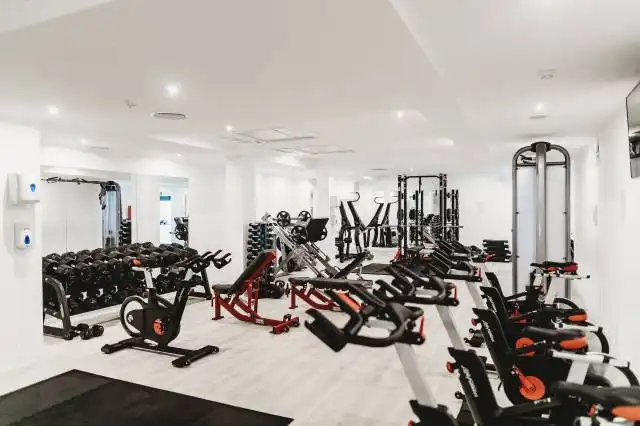Start a Boutique Gym
Infuse Your Personality: The Magic of Starting Your Boutique Fitness Haven
| Updated


BOUTIQUE GYM
A boutique gym provides a cozier, more personalized fitness experience that large-scale fitness chains may lack. These gyms aim to foster community and integrated wellness while offering top-of-the-line equipment, specialized workout classes, and experienced trainers. An admirable choice for a budding entrepreneur, a boutique gym can be your opportunity to bring life-changing fitness experiences to clientele, while infusing your distinct personality and style into every corner. Following this business idea, you'll not only be providing a platform for exercise but enhancing the appeal of healthy living.
Jump to Business Plan
RELATED BUSINESS IDEAS
Browse ALL Health & Beauty Innovations Business Ideas
Discover Your Perfect Domain
Unlock the door to your online success with our hand-picked selection of premium domain names. Whether you're starting a new venture or rebranding an existing one, the right domain can set the tone for your digital presence. Browse through our curated list, each with its unique potential to enhance your brand's visibility and credibility.
BOUTIQUE GYM MINI BUSINESS PLAN
This a quick reality check to help you identify the strengths and weaknesses of your business concept before you dive in.
Expected Percent Margin:
- Gross Margin: 70-80%
- Net Profit Margin: 10-30%
Earnings Expectations:
- Daily Earnings: $100 - $400 (Depending on memberships and personal training sessions)
- Weekly Earnings: $700 - $2,800
- Monthly Earnings: $3,000 - $12,000
- Annual Earnings: $36,000 - $144,000
Actions to Hit Those Numbers:
Property and Equipment:
- Initial Investments: Expect to spend at least $100,000-$200,000 for gym equipment and potential space renovations.
- Maintenance: Budget for regular equipment maintenance and repairs to keep clients satisfied and safe.
Marketing and Customer Acquisition:
- Social Media: Regularly post gym updates, health tips, and member spotlights on popular platforms.
- Promotions: Consider offering discounted memberships or "bring a friend" deals to attract new clientele.
Membership Management:
- Pricing Strategy: Keep memberships competitively priced, offering different levels to accommodate various budgets.
- Retention Strategies: Engage with members, solicit feedback, and continuously improve services to promote customer loyalty.
Staffing:
- Recruitment: Hire knowledgeable, friendly staff and personal trainers to foster a welcoming community.
- Training: Invest in staff training to keep everyone up to date on fitness trends and safety practices.
Cost Control:
- Rent: Aim for rent to be less than 10% of the total expected monthly earnings.
- Utilities and Maintenance: Budget at least $500-1000 monthly, depending on the size of your facility.
Business Operations:
- Operating Hours: To accommodate all members, operate on extended hours or 24/7 if possible.
- Membership Volume: Aim to maintain an active membership of at least 300-500 people.
Please note: These are generalized estimations and can vary depending on the location, specific business model, and local competition. It's always advisable to consult with a business advisor for personalized advice.
NOT WHAT YOU HAD IN MIND? Here are more ideas



Browse ALL Health & Beauty Innovations Business Ideas
Grab Your Business Website Name
Before you get caught up in the whirlwind of setting up your business, invest in a domain name. It's a small but significant step that lays the foundation for your brand and makes it easier for customers to find and trust you. Just like you wouldn't build a house without securing the land first, don't build a business without securing your domain name.
"Why? Can't that wait?" Here's why it shouldn't
Step 1: Determine if the Business is the Right Endeavor
Breakdown of Startup Expenses
Before starting a boutique gym, it is important to understand the startup expenses associated with the business. This includes the cost of renting or purchasing a space, the cost of equipment, and the cost of any necessary permits or licenses. Additionally, it is important to factor in the cost of marketing and advertising, as well as the cost of hiring any necessary staff. It is also important to consider the cost of insurance and legal fees associated with starting a business.
Breakdown of Ongoing Expenses
Once the business is up and running, it is important to understand the ongoing expenses associated with running a boutique gym. This includes the cost of rent or mortgage payments, the cost of utilities, the cost of staff salaries, and the cost of any necessary repairs or maintenance. Additionally, it is important to factor in the cost of marketing and advertising, as well as the cost of insurance and legal fees.
Examples of Ways to Make Money
There are a variety of ways to make money with a boutique gym. This includes charging membership fees, offering personal training services, and hosting classes or workshops. Additionally, it is possible to make money by selling merchandise, such as workout apparel and supplements. It is also possible to make money by offering online services, such as virtual classes or personalized workout plans. Finally, it is possible to make money by partnering with other businesses, such as nutritionists or massage therapists.
Step 2: Name the Business
Brainstorm When it comes to naming a business, the best place to start is by brainstorming. Think of words that are related to the business and its services. Consider words that evoke a feeling or emotion that you want customers to associate with your business. Write down as many words as possible and then narrow down the list to the ones that you like the most.
Research Once you have a list of potential names, it is important to research them to make sure that they are not already taken. Check the USPTO website to make sure that the name is not already trademarked. Also, do a quick search online to make sure that no other businesses are using the same name.
Test it Out Once you have narrowed down the list to a few potential names, it is important to test them out. Ask friends and family for their opinion on the names and see which ones they like the best. This can help you decide which name is the best fit for your business.
Consider the Future When choosing a name for your business, it is important to consider the future. Think about how the name will look on business cards, websites, and other marketing materials. Also, consider how the name will sound when you say it out loud.
Make it Official Once you have chosen the perfect name for your business, it is important to make it official. Register the business name with the state and obtain any necessary permits or licenses. This will ensure that the name is legally protected and that you can start using it for your business.
Step 3: Secure Funding
- Traditional Bank Loan
- Traditional bank loans are one of the most common ways to secure funding for a business. They are typically the most secure and reliable form of funding, but they also require a great deal of paperwork and can take a long time to be approved. Additionally, banks will often require collateral in order to secure the loan, which can be difficult for a new business.
- Crowdfunding
- Crowdfunding is a relatively new way to secure funding for a business. It involves setting up a page on a crowdfunding website and asking the public to donate money to help fund the business. This can be a great way to get the word out about the business and to raise money quickly, but it can also be difficult to reach the goal amount.
- Angel Investors
- Angel investors are wealthy individuals who are willing to invest in a business in exchange for a share of the profits. This can be a great way to get the funding needed to start a business, but it can also be difficult to find the right investor. Additionally, the investor may require a significant amount of control over the business, which can be difficult for a new business owner.
- Small Business Grants
- Small business grants are available from the government and other organizations to help small businesses get started. These grants can provide a great source of funding, but they can also be difficult to obtain. Additionally, the grant may come with certain requirements that must be met in order to receive the money.
Step 4: Find a Location
Considerations
- Cost
- One of the most important considerations when choosing a location for a boutique gym is the cost. The cost of the space will depend on the size and location of the gym, as well as any additional features that may be needed. It is important to research the area and compare prices in order to find the best deal.
- Accessibility
- Another important consideration when choosing a location for a boutique gym is accessibility. It is important to choose a location that is easily accessible to potential customers. This could include being close to public transportation or having ample parking.
- Competition
- It is also important to consider the competition when choosing a location for a boutique gym. It is important to research the area to determine if there are any other gyms in the area that could potentially compete with the business.
- Amenities
- Finally, it is important to consider the amenities that are available in the area. This could include things like restaurants, shops, and other attractions that could potentially draw in customers. It is important to research the area to determine what amenities are available and how they could benefit the business.
Step 4: Secure a Location
- Research the local market: Before committing to a location, it is important to understand the local market. Research the population, demographics, and competition in the area. Knowing the local market will help determine the best location for the boutique gym.
- Consider the size of the space: The size of the space will depend on the type of services the gym will offer. Consider the size of the space needed to accommodate the services and equipment.
- Consider the cost of the space: The cost of the space will be a major factor in the decision. Consider the cost of the space, as well as any additional costs such as utilities, insurance, and taxes.
- Consider the accessibility of the space: The location should be easily accessible to potential customers. Consider the proximity to public transportation, parking, and other amenities.
- Consider the aesthetic of the space: The space should reflect the brand and values of the boutique gym. Consider the layout, design, and decor of the space to create an inviting atmosphere.
Tips on Negotiating a Lease
- Research the local market: Before negotiating a lease, research the local market to understand the going rate for similar spaces. Knowing the local market will help determine a fair price for the space.
- Understand the terms of the lease: It is important to understand the terms of the lease before signing. Consider the length of the lease, the cost of the lease, and any additional fees.
- Negotiate the terms of the lease: Negotiate the terms of the lease to get the best deal. Consider negotiating the length of the lease, the cost of the lease, and any additional fees.
- Get the lease in writing: Once the terms of the lease have been agreed upon, get the lease in writing. This will ensure that both parties are held to the terms of the agreement.
- Consult a lawyer: Before signing the lease, consult a lawyer to ensure that the terms of the lease are fair and legally binding.
Step 5: Obtain Necessary Licenses and Permits
Before opening a boutique gym, it is important to obtain all of the necessary licenses and permits. Depending on the state and city, the types of licenses and permits needed will vary. Generally, a business license and a permit to operate a gym are required. Additionally, a permit to sell food and beverages, a permit to sell alcohol, and a permit to host special events may be necessary.
How to Obtain Licenses and Permits
In order to obtain the necessary licenses and permits, the business owner must contact the local government office to determine which licenses and permits are required. After the necessary licenses and permits are identified, the business owner can apply for them. The application process will vary depending on the state and city, but typically requires submitting an application and paying a fee.
Cost of Licenses and Permits
The cost of licenses and permits will vary depending on the state and city. Generally, the cost of a business license and a permit to operate a gym are relatively low. However, the cost of a permit to sell food and beverages, a permit to sell alcohol, and a permit to host special events can be more expensive. It is important to research the cost of licenses and permits in the area before opening a boutique gym.
Importance of Obtaining Licenses and Permits
It is important to obtain the necessary licenses and permits before opening a boutique gym. Without the proper licenses and permits, the business owner may be subject to fines or even have to close the business. Additionally, obtaining the necessary licenses and permits will help to protect the business from potential legal issues. Therefore, it is important to obtain the necessary licenses and permits before opening a boutique gym.
Step 6: Purchase Equipment
When starting a boutique gym, it's important to consider the types of equipment that will be needed. Depending on the type of gym, the equipment will vary. For example, a yoga studio may need yoga mats, blocks, straps, and bolsters. A weightlifting gym may need barbells, dumbbells, and weight plates. If the gym is offering group classes, equipment such as kettlebells, medicine balls, and jump ropes may be needed. Additionally, it's important to consider any additional equipment such as mirrors, sound systems, and fans.
Where to Buy Equipment
When purchasing equipment, it's important to consider both the quality and the cost. Many gyms opt to purchase used equipment, as it can be much more cost effective. However, it's important to make sure the equipment is in good condition and safe to use. Additionally, it's important to consider the warranty and return policy of the equipment. Many companies offer discounts for bulk orders, so it's important to consider this when purchasing equipment.
Insurance
When purchasing equipment, it's important to consider insurance. Many companies offer insurance policies that can cover the cost of any equipment that is damaged or stolen. Additionally, it's important to consider any liability insurance that may be needed. This can help protect the gym from any potential lawsuits.
Step 7: Market the Business
Once the business is up and running, it is important to market the business to potential customers. There are many different ways to market a boutique gym, such as creating a website, utilizing social media, and creating promotional materials. Additionally, advertising in local newspapers and magazines, as well as creating flyers and posters can be effective. It is important to find the right balance between traditional marketing strategies and digital marketing strategies.
Utilizing Digital Marketing
Digital marketing is an important part of marketing a boutique gym. Utilizing social media platforms such as Facebook, Twitter, and Instagram can be a great way to reach potential customers. Additionally, creating a website for the business and utilizing search engine optimization (SEO) can help to drive more traffic to the website. It is important to create content that is engaging and informative, and to post regularly to keep customers informed.
Utilizing Traditional Marketing
Traditional marketing strategies can also be effective for marketing a boutique gym. Creating flyers and posters and distributing them in the local area can be a great way to reach potential customers. Additionally, advertising in local newspapers and magazines can be a great way to reach a larger audience. It is important to create content that is engaging and informative, and to ensure that the advertisement stands out from the competition.
Utilizing Word of Mouth
Word of mouth is one of the most effective ways to market a boutique gym. Encouraging customers to spread the word about the business can be a great way to reach potential customers. Additionally, offering incentives such as discounts or free classes can be a great way to encourage customers to spread the word. It is important to ensure that customers are satisfied with their experience, as this will help to ensure that they will recommend the business to others.
Step 8: Hire Employees
When hiring employees for a boutique gym, it is important to find individuals who are knowledgeable and passionate about fitness. They should also be able to communicate effectively with customers and be able to provide a high level of customer service. It is also important to find employees who are reliable and trustworthy, as they will be handling money and other sensitive information. Additionally, it is important to ensure that the employees are properly trained and certified in the areas they will be working in.
Benefits of Hiring Employees
Having employees can help to reduce the workload of the owner and allow them to focus on other aspects of the business. Additionally, having employees can help to increase the customer base, as they will be able to provide more services and be able to handle more customers. Having employees can also help to increase the overall efficiency of the business, as they will be able to handle tasks that the owner may not have the time or resources to do.
Finding Employees
When looking for employees, it is important to look for individuals who have experience in the fitness industry and who have the necessary certifications. Additionally, it is important to look for individuals who are passionate about fitness and who have a strong customer service background. It is also important to look for individuals who can work well with others and who are reliable and trustworthy. Additionally, it is important to look for individuals who are willing to go the extra mile to ensure that customers are happy and that the business is successful.
Training Employees
Once the right employees have been hired, it is important to provide them with the necessary training. This should include training on customer service, safety protocols, and the use of any equipment that they will be using. Additionally, it is important to provide employees with any certifications that they may need in order to perform their duties. Finally, it is important to provide employees with ongoing training and education to ensure that they are up to date on any changes or new developments in the fitness industry.
Step 9: Open for Business
- Make sure to have a grand opening event to draw attention to your business.
- Invite local media outlets to cover the event.
- Have a ribbon cutting ceremony with local officials.
- Have promotional materials on hand to hand out to potential customers.
- Have a special offer or discount for the first few customers.
- Have staff on hand to answer questions and show customers around the facility.
- Have a plan for the day and make sure to stick to it.
- Make sure to have plenty of snacks and drinks available for customers.
Opening day is the culmination of all the hard work that has gone into starting a boutique gym. To make sure the day is a success, there are a few tips to keep in mind. First, it is important to have a grand opening event to draw attention to the business. Inviting local media outlets to cover the event is a great way to get the word out. Additionally, having a ribbon cutting ceremony with local officials is a great way to make the event more special. Having promotional materials on hand to hand out to potential customers is also important. Offering a special offer or discount for the first few customers is a great way to get people in the door. Having staff on hand to answer questions and show customers around the facility is also important. It is also important to have a plan for the day and make sure to stick to it. Finally, make sure to have plenty of snacks and drinks available for customers. This will make the grand opening event more enjoyable and memorable for everyone.
EXPLORE MORE CATEGORIES
Browse ALL Business Idea Categories
TAKE THE NEXT STEPS










